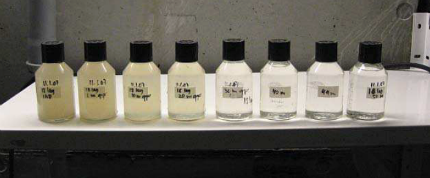The City of Copenhagen saves on sewer and water treatment plant capacity by purifying rainwater from roads, promenades and roofs separately, so that it can be channelled directly into watercourses or the harbour.
A process known as dual porosity filtration can be used to remove oil and heavy metals from the rainwater that flows off the roads. This can be done so efficiently that directing the water straight into watercourses or the sea is environmentally sound. Naturally, the method can also be applied to water from promenades and roofs, which is less contaminated than water from roads. This spares sewers and treatment plants from large quantities of water.
The water can also be recycled for recreational activities in canals and lakes. This has been proven by an experiment conducted by the University of Copenhagen and the City of Copenhagen in collaboration with a number of other partners in Ørestad, a new district of Copenhagen close to Kastrup Airport. Due to the success of the experiment, dual porosity filtration systems are set to be established in other parts of Denmark's capital.

Illustration of the "sandwich structure" of dual porosity filtration. The dirty water flows horizontally into the filter, mainly via the high-porosity layers whose hydraulic conductivity is many times greater than the low-porosity trapping layers that contain the filter medium. During the time it takes for the water to flow from inlet to outlet, impurities are deposited on the underlying low-porosity layer. Illustration and text by the University of Copenhagen's Faculty of Life Sciences
Cost
The contractor's costs and the filter medium are the most expensive items associated with construction of the system. In addition to these costs is the land value of the site on which the filter is set up.
Cooperation
The pilot project at Ørestad was carried out as a collaboration between the City of Copenhagen's technical and environmental department, Københavns Energi, CPH City and Port, Rambøll, The Realdania Foundation, the Danish Agency for Science, Technology and Innovation and Forest and Landscape at the University of Copenhagen. The latter invented and filed a patent application for the dual porosity filtration method, while the university's Tech Trans unit is responsible for the commercialisation of the technology.
Involvement of management
Copenhagen City Council has reviewed the dual porosity filtration method, along with a number of other climate change adaptation initiatives. This is a research project with a large number of collaborating partners. Therefore, there is no management. The steering committee consists of delegates from the City of Copenhagen, Københavns Energi, CPH City and Port, Rambøll and the University of Copenhagen.
Process
The project at Ørestad is a pilot project, conducted as a large-scale laboratory experiment. The idea behind the dual porosity filtration principle arose in 2001 and was tested between 2001 and 2004 in a 2 metre long laboratory filter. The pilot plant for purifying road water was built in Ørestad in 2005 and 2006. After an initial commissioning period, the first occurrences of rainwater were collected and analysed from January to June 2007. The results of the analyses showed that the method works and that the purified water complies with the thresholds specified by the Water Framework Directive. A pilot plant was then set up over a stretch of 50 metres. The results were satisfactory here, too. Full-scale trials are therefore to be conducted covering entire districts of central and southern Ørestad.
Technical complexity
Dual porosity filtration consists of two layers: a high-porosity layer of filter medium on top and a low-porosity layer underneath. Inspiration for the idea was obtained from nature, where precipitation is purified by the lime in the soil as it seeps down into the groundwater from the surface.
No chemicals are added in the Ørestad project, and neither pumps nor other similar systems are used, as the water flows through the filter under gravity only. Knowhow is required to set up the system correctly, but operating the system is easy.

Photograph: Samples taken along the filter. Contaminated water at the inlet on the left. Purified water at the outlet on the right.
Potential for climate change adaptation
As a high proportion of the surfaces in the City of Copenhagen are asphalted, rainwater from roads, promenades and roofs account for two thirds of the water that flows into the municipality's sewers and treatment plants today. Dual porosity filtration can therefore make a significant contribution to the municipal authority's goal of reducing the volume of water that flows into its sewers by 30 percent. The 30 percent target was set based on an expectation that tomorrow's climate will produce 30 percent more rain.
"We have had to look 50 to 100 years ahead in order to draw up the climate change adaptation plan. No municipal authority has adopted such a long-term perspective before. Work on the plan has consequently progressed quickly. There is no doubt that last summer's cloudburst was an eye-opener," says Jan Rasmussen from the City of Copenhagen's technical and environmental department.